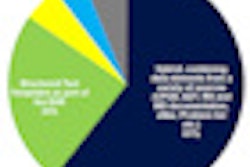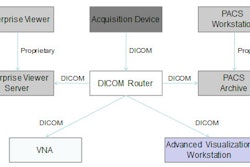The rate of adoption of structured radiology report templates has been compared to the pace of a tortoise. Yet structured reports ostensibly have greater clarity and more uniform content. A comparative study published online April 25 in Radiology tested this premise.
Radiologists at Memorial Sloan-Kettering Cancer Center in New York City converted to structured report templates in 2009. The project took six months of preparatory work, and two years later it remains a work-in-progress. The department's objective was to improve its written reports, producing greater consistency for optimal clinical care and research, as well as better communications to the patients. But did it succeed?
Researchers decided to formally compare the content, clarity, and clinical usefulness of conventionally prepared, free-form reports with those developed using radiology department-adopted structured templates. Their analysis of 330 randomly selected radiology reports of body CT scans showed that the structured reports were preferred by nonradiologists and radiologists alike.
Transitioning to structured reporting
"With 95 faculty, 36 residents, and 25 fellows, the reports produced by our steadily growing department had a variety of contents and formats," Dr. David Panicek, vice chair for clinical affairs of the department of radiology, told AuntMinnie.com. "We were early adopters of speech recognition systems and have been preparing all reports utilizing this software since 2006. Speech recognition programs are ideal for implementing report templates."
In early 2009, a structured report committee was formed that consisted of faculty radiologists representing various radiology subspecialties. They developed a standardized master template, the content of which was tailored to the specifics of the types of radiology exams and procedures performed. The templates were modified as needed based on feedback from referring clinicians to maximize their clinically relevant content. A total of 214 distinct templates were produced, of which 43 templates alone were for different CT exam protocols.
"After these templates were introduced into our clinical practice, we received nearly uniform praise from our colleagues for the increased consistency of our reports and the increased ease with which they could be read and understood," Panicek said.
The committee then addressed the task of clarifying the words and phrases used to express the degree of certainty in a radiologist's interpretation. The committee developed a small, well-defined lexicon of terms.
A percentage associated with each term indicates the radiologist's best estimate of the probability of that diagnosis based on his or her judgment, Panicek explained. "This initiative improved our consistency in expressing the degree of certainty of a given radiologic interpretation. Such estimates have always been in each radiologist's mind, but use of the lexicon makes them explicit in the report."
In oncologic imaging, it is essential to compare the current study with prior ones to assess any changes. As another benefit, the structured report templates enable referring physicians to rapidly identify terms of interest to them.
Many radiologists, especially the residents and fellows, immediately understood the benefits of using structured reports, Panicek said. Radiologists who were resistant to changing the reporting patterns they had developed during years of practice experienced peer pressure from referring physicians to conform. By July 2009, the radiology department was exclusively using the structured report templates.
The face-off: Conventional versus structured
When the department decided to conduct a formal comparison of the two types of reports, body CT reports were selected because they are among the longest and most complex in oncologic imaging. At Memorial Sloan-Kettering, approximately 280 body CT scans are performed each day.
Eleven physicians participated in the comparison: three radiologists, three radiology fellows, three surgeons, and two oncologists. The radiologists represented a senior, midcareer, and junior radiologist.
Each participant reviewed 15 conventional and 15 structured randomly selected reports of body CT examinations of the chest, abdomen, pelvis, or abdomen and pelvis.
The conventional reports were from scans taken between January and June 2009, while the structured reports were from June through September 2009. The participants were blinded to the dates and to all patient demographic information. The reports reviewed by the nonradiologists were about patients whose tumor types related to their areas of subspecialization.
The respondents were asked to rank each report based on satisfaction with its content and clarity on a scale of 1 (very dissatisfied/very confusing) to 10 (very satisfied/very clear). They were also asked to categorize the effectiveness of each report in explaining the cancer patient's position on a clinical spectrum using a previously developed five-level radiology report grading scale.
Comparison of median ratings
|
"Physicians displayed significantly greater satisfaction with the content and clarity of structured reports than with the content and clarity of conventional reports," the authors wrote. "Since satisfaction with the content and clarity of conventional reporting was high, the fact that a significant improvement could be achieved with structured reporting is remarkable."



















